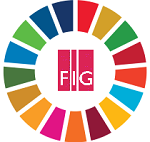News in 2022

|
FIG and the Sustainable Development Goals - Commission 5
July 2022
FIG Task Force on FIG and the Sustainable Development Goals together
with the ten Commissions have worked on their role on the sustainable
development goals relevant for their Commission.
Commission Chair Dan Roman gives his Statement on the
sustainable development goals in relation to Commission 5 -
Positioning and Measurement
|

|
The key involvement in Commission 5 is in developing the framework
from which other geospatial data are obtained, modeled, and analyzed in
order to make appropriate decisions and take effective actions.
Therefore, those aspects of the SDG’s that have an explicit or implicit
relationship to geospatial requirements are directly impacted by
Commission 5’s body of work. Dan Roman shares how surveyor contribute to
these SDG's.
Commission 5 focuses on meeting the highest level of accuracy for
Positioning and Measurement. It provides the tools, techniques and
procedures to educate and train surveying professionals everywhere.
Appropriate methodology for data collection and processing are required
to be successful in an era of global, integrated geospatial data. For
many geospatial applications, positioning of built infrastructure and
measurement of physical quantities of the Earth require precision and
accuracy as well as a tie to a consistent reference framework. The
ability to make all the geospatial data interoperable is one of the four
tenets of the F.A.I.R. principals.
As such, Commission 5 touches on all geospatial aspects of the SDG’s
including: (1) Standards by which observations and analysis are
performed, (2) a Geometric Reference Frame to reference geospatial data,
(3) a Geopotential Reference Frame to reference water heights, (4) GNSS
tools and techniques for determining geospatial coordinates, (5)
Multi-Sensor Systems that integrate other data sensors and techniques,
and (6) Cost Effective Tools to make all this more accessible in
developing countries.
The key involvement in Commission 5 is in developing the framework
from which other geospatial data are obtained, modeled, and analyzed in
order to make appropriate decisions and take effective actions.
Therefore, those aspects of the SDG’s that have an explicit or implicit
relationship to geospatial requirements are directly impacted by
Commission 5’s body of work.
SDG 6: Water and Sanitation
The flow of fluids that is subject to the Earth’s gravitational field
and are measured via leveling, geopotential models, etc. The Earth’s
gravity field doesn’t know political boundaries, so a uniform basis for
determining the height and flow of water will aid transnational efforts.
Accurately determining the height of water will better describe the flow
of water and, thereby, provide efficient controls and mitigation. This
applies broadly – pipeline flows, aqueducts, sewer pipes, and river
overflow into flood plains.
SDG 7: Affordable and Clean Energy
The focus on renewable energy here is hydroelectric as the clean,
affordable energy source most related to Commission 5. Understanding the
flow of water improves the regulation of this renewable source. By way
of example is the hydrologic and hydraulic modeling of large bodies of
fresh water such as the Great lakes. The large bodies of water bounding
international borders require a common means of measurement to
facilitate transnational cooperation and optimization of the renewable
energy resource. Monitoring of gauges along streams and rivers will
mitigate potential flooding issues (SDG 6) but also aid in optimizing
water flows via damming.
For coastal Nations, the potential for harvesting tidal and wave
forces exists. Modeling of the behavior of these water surfaces and
their stored potential energy is likewise facilitated by an integrated
approach to positioning and measurement along with hydrographic models.
SDG 9: Industry, Infrastructure and Innovation
The key to success here is in organizing the geospatial data of the
Industry and Infrastructure. Smart Cities, Digital Twins, BIM,
autonomous vehicles, precision navigation and many other areas related
to Industry and Infrastructure will require Innovation globally but
implemented locally – especially in developing countries.
Ensuring that all the geospatial data is interoperable will better
ensure success. Ensuring that national reference systems are internally
precise is important here. However, equally important is ensuring that
they are tied to the international reference system to ensure maximum
compatibility between Nations. Ensuring that all the geospatial data
supporting these areas are accessed using consistent technology and
implemented in a common framework will better ensure developing Nations
will reap the benefits of a modernized world.
SDG 11: Sustainable Cities and Communities
The work of Commission 5 focuses on developing a geospatial reference
system for locating real world infrastructure into a digital, geographic
information system. BIM focuses on 3D positioning of walls, boundaries,
conduits are located inside a structure. By applying absolute
coordinates, the BIM for all structures can be integrated into a digital
twin that provides not only the external boundaries of structures but
also the internal component locations. This extends throughout the city
to locations of buried cables, sewers, pipes to provide an overall model
of city. This digital twin then provides the basis for sustaining and
improving conditions in these communities.
A digital twin not only provides the basis for sustaining the city
internally, it can then be related to external factors such as a storm
surge, flooding river or even the more inexorable change in sea level.
Better relating climate related disasters to the built infrastructure
will result in improved emergency and coastal management. This also
applies to measurement of pollutants and other geospatially correlated
variables. Knowing where something is located is as important as knowing
how much is there for proper modeling.
SDG 13: Climate Action
Commission 5 provides support by determining a common reference
system for geospatial coordinates and providing the tools & training
necessary to provide uniform access. By providing this basis,
observations of changes in climate can better integrated to develop
refine models for prediction and, presumably, mitigation.
SDG 14: Conserve and sustainably use the oceans, seas and marine
resources
With the advent of GNSS-derived hydrographic soundings, ocean
measurements and modeling can be combined with their terrestrial
counterparts to form a more integrated system. One area of cous is
better relating bathymetric surveys through the coastal zone onto shore
with digital elevation models. This forms a seamless model of the
Earth’s crust from open air to beneath the water. Additionally, Streams
and rivers are often gauges and measured based on terrestrial systems.
Ocean modeling usually is in a different geospatial system. By adoption
of a common geospatial system, the affects of pollutants running off
from terrestrial sources downriver to the ocean can be better modeled.
SDG 15: Life on Land
A common geospatial reference system is integral to a number of areas
for this SDG. By providing a common geospatial framework, data from
disparate sources can be better integrated to meet these targets.
Ecosystems are located in niches determined by lateral extents and, more
specifically, the height above water. Different topics of flora exist in
different stages above the water (e.g., rising sea levels destroy the
roots of mangroves). Understanding these observations in a broader
context and a common geospatial reference system better ensures the
success of efforts to conserve, restore or sustain these different
environments.
Dan Roman
and Paula Dijkstra
July 2022




























